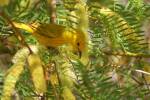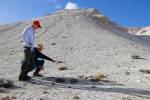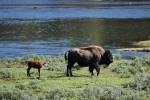It’s easy to establish a certified wildlife habitat
Even if you have a postage stamp-size yard or farm, you can create a beautiful wildlife habitat in your yard, and it's simple to do.
Dan Secinaro and I will show you how to establish a wildlife habitat in your yard at 1:30 p.m. every Saturday and Sunday in July at the Springs Preserve, 333 S. Valley View Blvd. There are five elements necessary to certify your yard.
The first element is food. Consider trees and shrubs that produce fruit and seeds. You can use bird feeders to attract more birds.
Don Fabbi, who has a certified wildlife habitat, uses fruit trees. He shares the fruit with the wildlife. He also has pyracanthas, blackberries, raspberries and strawberries tucked under these trees for their feasting. If times get tough, Fabbi fills his bird feeders. But birds fight over the seeds, so he spreads seeds over his lawn.
Water is the second element. Create a birdbath or shallow water source for birds to drink and wash. Fabbi loves watching birds bathe at his water's edge.
Wildlife needs and enjoys cover from predators, so shelter is the third component needed. Attain this by planting heavy shrubbery in your landscape.
Fabbi grows unusual plants such as peanuts, bananas and cotton, among others. He tucks in irises, petunias, marigolds, zinnias, lilacs and violets with the shrubs. These plants encourage butterflies and other insects to visit his yard and create excellent hiding places for young birds.
Fabbi builds unique butterfly "condos" to keep insects coming back. Inside he put strips of pine trees in corners to assimilate natural places for them to lay eggs. To make them more at home, he placed a colorful fake monarch butterfly on the condo.
The fourth element is having places for animals to raise offspring. These areas need to be safe and secure and will vary depending on the types of wildlife you're trying to attract. All the plants in Fabbi's yard serve as hiding places.
The fifth component is sustainable gardening practices. This means planting native vegetation, reducing chemicals and building healthy soil. Keep in mind your habitat affects the environment, so anything you can do to promote healthy vegetation helps.
Fabbi has a tortoise named Minnie whom he loves. "If someone wants a pet, there isn't anything better than a tortoise, and I'm including dogs and cats," Fabbi said. "She is a real gentle creature, and I totally forget about her while she hibernates. She doesn't bark or cause trouble and follows me around like a little pup, and the kids dearly love her."
You can have your backyard certified as a wildlife habitat by contacting the National Wildlife Federation. You must meet all five criteria before applying. For more information and to get started, visit secure.nwf.org/backyardwildlifehabitat/certify/page1.cfm on the Internet.
IRIS PLANT SALE
The Las Vegas Iris Society's iris sale is from 9 a.m. to 3 p.m. today at Plant World Nursery, 5311 W. Charleston Blvd.
MASTER GARDENERS HONORED
Nevada Cooperative Extension recently honored more than 300 Master Gardeners. They contributed 38,104 volunteer hours on community projects making a valued contribution of $794,468 for the valley.
The honorees are:
Regina Jewell received the Silver Trowel, the highest award, for donating the most hours. Kimberly Williams, Henry Malen, Yutaka Nomura, Tom Grimm, Nancy Grimm, Buzz Wadsworth, Helen Brown, Jean Engelmann, Judith Kafantaris received the Silver Star award for more than 350 hours of service.
Al Valdez received the Silver Phone award for the most hours answering the Helpline. Jean Engelmann, Kathy Fournier and Judith Kafantaris received Helpline certificates. Last year, they answered 4,244 phone calls and emails.
Erin Beesley, Phyllis Bender and Margaret (Peg) Cornett received 10-year service pins.
The Exceptional Service award salutes Barb McGibbon, Acacia Park; Don Fabbi, Doolittle Senior Center Community Garden; Jane Gillespie, Home Gardening Helpline; Arlene Ralbovsky, Library; Pat Westlund, Lieburn Senior Center Community Garden; Mary Rider, Mojave Guides; Joy Mandekic, Nathan Adelson Hospice Healing Garden; Jim Stone, University Orchard; Clara Hatz, PLANT (Project for Landscape & Natural Tranquility); Vicki Yuen and Peg Cornett, Propagation/Watering at the Springs Preserve and Mary Lawton, Winchester Park for their long-term leadership of these projects.
A new category called the All-Stars honored Richard Cutbirth, Don Fabbi, Jane Gillespie, Richard Leifried and Cliff Wood for consistently exceeding 50 hours since joining the program.
Linn Mills writes a garden column each Sunday. You can reach him at linn.mills@ springspreserve.org or call him at 822-7754.























